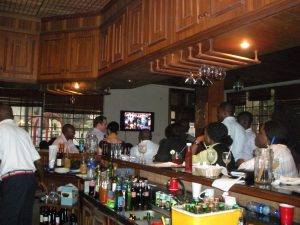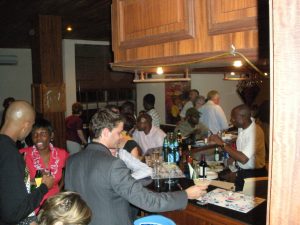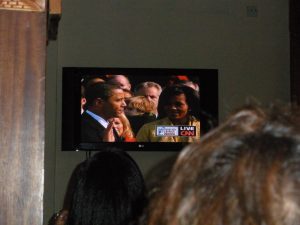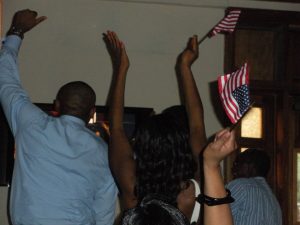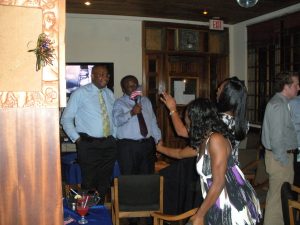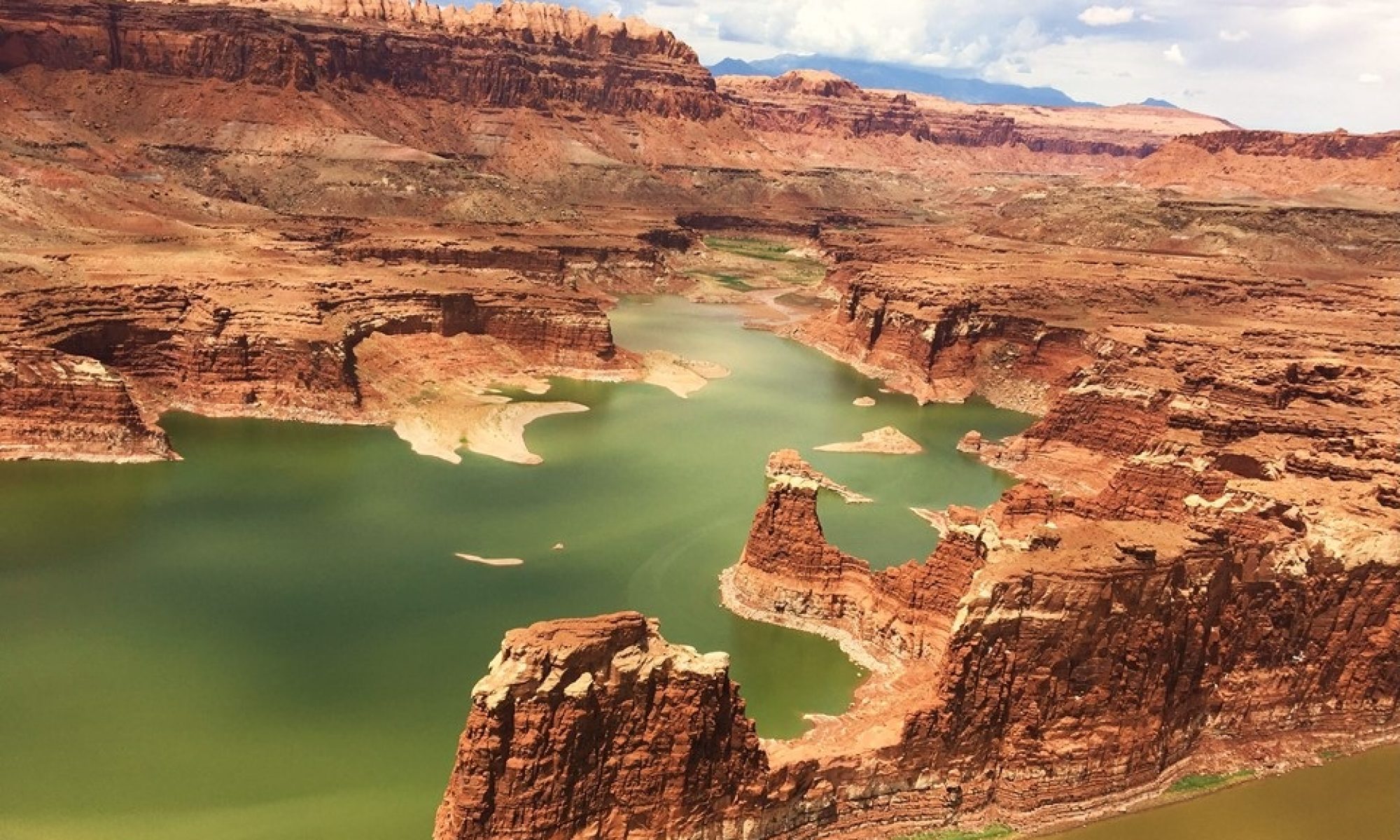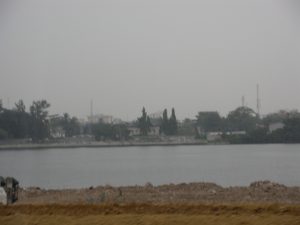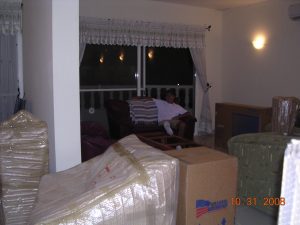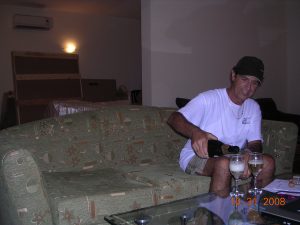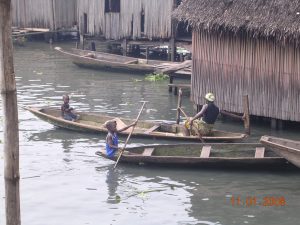On Thursday, October 2nd, I received a call from the American High School Football,
(Soccer), Coach, Columbus, asking me if I wanted to accompany him to a soccer competition on Saturday. In addition to coaching at the American High School, Columbus runs a Football Academy nearby on the Lekki Peninsula. The Lekki Peninsula area is relatively upper-middle class in Lagos, and most of the people in the area are hardworking and educated with a modest income. However, our adventure this weekend would take us elsewhere.
In January, 2008, the Lagos State of Nigeria decided to host a year-long “Street Soccer” 5 vs. 5 Tournament, open to all registered Football Teams within the Lagos State. The purpose was to identify new, upcoming Nigerian Talent and allow young footballers to emerge. MTN, one of the major local cell phone providers, provided major sponsorship, the State Government provided guaranteed medical insurance to the players, and thousands of teams were registered for the event in January. Competition began in February, and by this weekend now in October, the competition was down to the top 80 teams – 10 teams each at 8 different sites spread around the State of Lagos. The competition this Saturday would be a strictly 1 game each knock-out competition to reduce the number of teams to 40. These 40 would then be regrouped into 10 brackets of 4 for round-robin play, with 2 teams from each bracket moving on to a “finals” championship in November. The Tournament winning Team will receive 2,000,000 Naira, (~$18,000), and trips to Brazil to play, Runner-Up with 1,000,000 Naira and trips to South Africa to play, and 3rd place with 750,000 Naira and trips to Ghana to play.
I met Columbus at the American School at 8:30am to travel to one site of the competition. Columbus’ Academy has an under-19 group, but half of the players would be at exam today, meaning that they would have to play without any substitutes. Also, they were drawn to play today at “Maracana Field” in Apapa…a hotbed of football for Nigeria in the middle of some of the most densely populated poor slum areas of Lagos. This particular pitch is named in honor of the famous stadium in Brazil – their homage locally to the sport. Columbus had himself grown up in the area, but had not been back to this hallowed ground for over 16 years. Numerous of Nigeria’s professional footballers grew up and learned a passion for the sport here, and I was eager to see the ground for myself.
Maracana Field was not easy for us non-locals to find. After traveling to the Apapa area, we found ourselves on very narrow streets during Saturday morning market hours, surrounded by a busy, bartering mass of humanity. There is no doubt in my mind that I was likely the only “Oyinbo”, (pronounced ‘ow-wee-bo’ – meaning ‘white person’), within a few miles, among over a million Nigerians. In many ways it way humbling, but mostly, it meant I was a curiosity there. After winding our way through 20 blocks of dusty, dirt, potholed roads, and moving the throngs from in front of us through persistent horn-blowing and car-creeping, and stopping to ask direction 3-5 times, we finally found the pitch at 9:20am.
Unfortunately, I had forgotten my camera, but I can describe the scene for you clearly: The area was the size of 3-4 full size pitches with only a modicum of grass remaining at the extreme edges. Although the ground was dirt from the constant local play, it was not sandy or soft, and without wind or rain, would allow a technical game to be played. There were permanent goals, and sets of smaller temporary goals around, and the perimeter of the field was lined on 2 sides by the walls and kitchen windows of the surrounding neighborhood. The 3rd side was bounded by the wall of the local school, and the 4th boundary was the classic galvanized steel fence we customarily find lining an automotive salvage yard in the U.S. Finally, the scene was held together by people playing – no organized play, just groups of kids from 4 years old to 19 years-old playing 1 vs. 1, 4 vs. 1 keep away, playing little 6-a-side soccer, etc. There was no actual field, but clearly on this Saturday, one would be needed.
The games this day were slated to start at 9:00am, and would consist of 5 games on 45 minute intervals, with 10 minute halves each. At 9:30am, they started to create the pitch! The Rope-Man and Ruler-Man worked together to lay 60- by 40-yard touchlines, and the Liner-Man put fresh sawdust and wood clippings along the rope to create the boundaries. Two goals were moved into place, 10 boards were moved to the sidelines for sponsor banners, and 20-ft tall wind-sails, with ‘MTN’ on them, were erected around the field. The Commissioner’s Tent was erected, the referees arrived, the Teams were warmed-up, and by 10:45am play was started. I was introduced as a visiting Coach from the U.S. and given an excellent viewing seat of prominence under the tent with the Commissioners.
Before the matches, I met Columbus’ Team, and their Assistant Coach Martins, who had just returned from receiving his USSF “B” Coaching License in the U.S. Columbus’ Team drew the third match of the day, and the first two matches were skillful and entertaining. All players were fast and technically skillful – some very much so. However, there was clearly a strong differentiation in the players’ tactical and decision making ability. The first game was dominated by errors that cost one team a 2-1 loss, although they dominated possession and chances on goal. The second game was evenly matched until late when a goalkeeper ventured too far forward on a offensive corner kick, and got caught terribly out of position, a 1-0 loss.
Columbus’ Team played skillfully, and tactically smart for a team having no subs. They shot often, and occasionally from distance, as it served to allow them to pace themselves for the whole game, and they won handily, 2-0.
After the game, some of the staff wanted to say “hi”, and asked about coaching, coaching courses, and football in America, both professional and in Colleges. The little boys at the field were excited, but shy, to come up and say “hi” to the Oyinbo, but you could see their eyes were wide with wonder and delight. We gave Columbus, Martins and Columbus’ brother a ride back to the American School to catch their local transport, but as is typical on mainland Lagos on Saturday afternoon, the traffic made for a 90 minute trip back.
All in all, it was an exciting and educational day, and a great chance to see the emerging talent within the Nigerian football world. Watch out, World! By the way, the FIFA Under-17 Boys World Championships will be in Nigeria in 2009 – I hope to get to see some matches, and who knows – maybe some of the boys I saw today.
